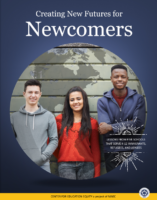
Lessons from Five Schools that Serve K-12 Immigrants, Refugees, and Asylees
Given the influx of immigrants and refugees over the past several years, newcomer students are found in the classrooms of small towns, suburbs, and big cities across the country and they bring with them a world of culturally diverse experiences and knowledge. Newcomers face myriad challenges to adapt and succeed in their new home and schools. They must learn how to navigate a new culture socially, master a new language, and adjust to a new, and typically different, educational system. Many of these students enter our schools with little or no formal education or fluency in English. Some have fled terrible conditions in their homelands. Others are here without their families. Despite these challenges, all share dreams of being successful students and productive members in our communities, while remaining linked to their cultures and native languages as they become first generation Americans.
To help make these dreams come true, we searched for “bright spots,” schools that offer promising and effective strategies for newcomers in K-12 classrooms. In this report, we focus on five very different schools that serve newcomers, each offering promising strategies, proven approaches, and fresh ideas that can benefit all educators, but especially those who work with immigrant and refugee students. We discuss curriculum and instruction, professional learning, school orientation, social-emotional and health support, and ways to partner with newcomer families and communities. We learn how newcomer schools assist students to adjust and thrive.
This report was developed through a partnership between MAEC and WestEd. The main author is BethAnn Berliner, Senior Researcher/Project Director at WestEd.
Click here for more information and to download the publication.

